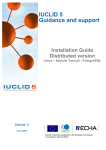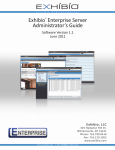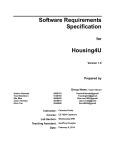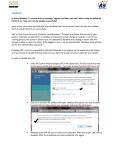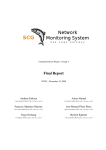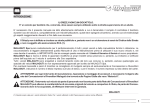Download Ubicore 3.2 Installation Guide - Linx & Postgres
Transcript
Rev A1 Ubicore, version 3.2 Installation Guide for Unix and Postgres DB Copyright Makewave AB 2009. All right s reserved Ubicore 3.2 Installation Guide - Linx & Postgres Table of Contents Table of Contents 1 Introduction.....................................................................................................................................3 1.1 Prerequisites..............................................................................................................................3 1.2 Overview...................................................................................................................................3 2 Postgres Installation and Configuration........................................................................................3 2.1 Running a separate database machine......................................................................................3 3 Installing Ubicore............................................................................................................................4 3.1 Installing the Ubicore server.....................................................................................................4 3.2 Initializing the Ubicore DB.......................................................................................................4 3.2.1 Initializing the DB on a fresh installaion..........................................................................4 3.2.2 MIgrating from Ubicore 3.1..............................................................................................4 3.3 Configuring Ubicore.................................................................................................................5 3.3.1 Tomcat configuration........................................................................................................5 3.3.2 Database Connection ........................................................................................................5 4 Starting / Stopping Ubicore............................................................................................................5 4.1 Starting Ubicore........................................................................................................................6 4.2 Stopping Ubicore......................................................................................................................6 4.3 Running as service....................................................................................................................6 5 Testing the installation....................................................................................................................6 6 Configuring Apache HTTP Server (optional)...............................................................................6 7 Further Reading..............................................................................................................................6 Appendix A – Preparing a Ubuntu Server ......................................................................................7 1 Introduction.....................................................................................................................................7 2 PostgreSQL......................................................................................................................................7 3 Installing Java:.................................................................................................................................7 4 Creating a Ubicore User and Group..............................................................................................8 5 Installation Notes.............................................................................................................................8 5.1 Installation failure due to jsvc...................................................................................................8 5.2 Redirecting to the portal web app.............................................................................................8 6 Starting Ubicore as a Service..........................................................................................................8 2 Ubicore 3.2 Installation Guide - Linx & Postgres 1 Section 1 Introduction Introduction This document outlines the steps that need to be taken to install the Ubicore server on a Unix based computer system such as the different Linux distributions or Mac OS X. Please refer to the corresponding installation guides for other operating systems, such as Windows. 1.1 Prerequisites The reader of this guide is assumed to have Administrator rights and previous experience of installing software and performing administrative tasks on the target system. It is required that Java 1.5 or later is installed, including a javac compiler (A Java Runtime environment, like JRE from Sun, does not usually contain this). Ubicore has been tested with Sun JDK 1.5.0_06. By default the Ubicore server installation package assumes that it is installed in ‘/opt/java/jdk1.5.0_06’. The Appendix A describes how to prepare the Ubuntu Linux distribution for Ubicore. 1.2 Overview The Ubicore server consists of three main software components: • PostgreSQL Database • Ubicore (running inside Apache Tomcat Servlet Container) • Apache HTTP Server (optional) Apache Tomcat is included in the Ubicore installation package and will be installed by the install script. PostgreSQL and Apache HTTP Server must be installed separately according to their respective documentation. PostreSQL may be replaced by other SQL databases with JDBC support, e.g Oracle. This guide will only explain how to install using PostgreSQL however. 2 Postgres Installation and Configuration Installation and configuration of the PostgreSQL database server is needed before continuing with the installation of Ubicore. It is recommended to use PostgreSQL version 8.2 or later. Instructions for installation is available on: http://www.postgresql.org/docs/8.2/static/installation.html The Ubicore installation script assumes that there is a super user ‘postgres’ defined as in the PostgreSQL installation guide. 2.1 Running a separate database machine This guide and the Ubicore installation package assumes that the PostgreSQL database server is running on the same machine as the Ubicore server. Note that if you are planning run the database on a separate machine from the Ubicore server or if you need to access the database server from other machines in your network, you will need to 3 Ubicore 3.2 Installation Guide - Linx & Postgres Section 2 Postgres Installation and Configuration change the settings in the postgresql.conf file in the PostgreSQL data directory (usually /usr/local/pgsql/data/): http://www.postgresql.org/docs/8.2/static/runtime-config-connection.html You may also need to add trust records to the pg_hba.conf file (usually /usr/local/pgsql/data/pg_hba.conf): http://www.postgresql.org/docs/8.2/static/client-authentication.html 3 Installing Ubicore Before installing Ubicore v3.2 any other instance of Ubicore should be stopped before proceeding with the installation. When making an upgrade from a previous version, Ubicore 3.2 can be installed over the previous installation. Ubicore v3.2 may of course also be installed separately, not overwriting any previous installations. 3.1 Installing the Ubicore server It is recommended to install Ubicore in the /opt directory of the file system. Make sure that your user have permission to write in the /opt directory and navigate there: $ cd /opt Unpack the Ubicore installation package: $ tar -zxvf <path>/ubicore_<version>.tar.gz Run the installation script: $ /opt/ubicore/bin/install.sh After successful completion the install script has Installed Apache Tomcat server in /opt/tomcat/apache-tomcat-<version>. 3.2 Initializing the Ubicore DB Make sure that the PostgreSQL database server is running and fully functional. It is needed to be able to complete the installation of Ubicore. 3.2.1 Initializing the DB on a fresh installaion To initialize the Ubicore DB on a fresh installation run the init script: $ /opt/ubicore/db/bin/init_db.sh During the installation you will be prompted with the password for the ‘ postgres’ database user, and later with the password for the ‘ubicore’ database user. The later has the default password ‘ubicore’. 3.2.2 MIgrating from Ubicore 3.1 When upgrading from Ubicore 3.1 to 3.2 run the init script with additional flags: 4 Ubicore 3.2 Installation Guide - Linx & Postgres Section 3 Installing Ubicore $ /opt/ubicore/db/bin/init_db.sh -m 3.1-3.2 This will migrate the DB to 3.2 format. To check which upgrades are possible, supply the -l flag, e.g. $ /opt/ubicore/db/bin/init_db.sh -l 3.3 Configuring Ubicore Ubicore is configured to run on port 8080 and to connect to the postgres DB on the same host. If these default settings should be changed, the following sections describe how to apply changes to the configuration. 3.3.1 Tomcat configuration By default Ubicore is configured to run on port 8080. If you wish to run on other ports it is required to edit the Ubicore runtime configuration available in ubicore\tomcat\conf\server.xml. Changing the line: <Connector port="8080" /> to <Connector port="80" /> will make the server run on the standard HTTP port. More documentation on Apache Tomcat server.xml configuration is available on: http://tomcat.apache.org/tomcat-5.5-doc/config/ 3.3.2 Database Connection By default Ubicore is configured to connect a PostgreSQL database on the local machine using the default port (5432), the schema ‘ubicore’ and the database user ‘ubicore’. Should you choose to install the database on another machine or running on another port, schema or user, it is required to edit the Ubicore runtime configuration available in ubicore\tomcat\ conf\server.xml. Documentation for the Apache Tomcat Resource directive is available on: http://tomcat.apache.org/tomcat-5.5-doc/jndi-datasource-examples-howto.html Documentation for the PostgreSQL URL is available on: http://jdbc.postgresql.org/documentation/81/connect.html 4 Starting / Stopping Ubicore Before starting the server you may need to edit a few parameters in the start script. The start script can be located at: ubicore/bin/ubicore.sh 5 Ubicore 3.2 Installation Guide - Linx & Postgres 4.1 Section 4 Starting / Stopping Ubicore Starting Ubicore To start Ubicore, run as root: $ /opt/ubicore/bin/ubicore.sh start 4.2 Stopping Ubicore To stop Ubicore, run as root: $ /opt/ubicore/bin/ubicore.sh stop 4.3 Running as service The supplied start script is a customized version of the default start script shipped with tomcat. This may be modified or used to run ubicore as a service. Please refer to the tomcat documentation for achieving this. 5 Testing the installation To test the installation of Ubicore, visit the Ubicore Portal: http://<hostname>:<port>/portal/ 6 Configuring Apache HTTP Server (optional) It may be required in some environments that the Apache Tomcat installation is not directly accessible from external networks such as the Internet. This can be for security reasons, to implement load balancing, to implement secure HTTP connections using SSL or make use of certain Apache HTTP server features etc. An option in this case is to install an Apache HTTP server to front the Apache Tomcat server(s). There are two options in doing this: using the module mod_jk using built in proxy functionality The mod_jk may be desirable for performance reasons and should be easy to configure if using Apache HTTP Server 2.2. The configuration of this option may however be tricky if using other versions of Apache HTTP Server. The second option has been thoroughly tested with Ubicore and the supplied configuration should work well with most Apache HTTP Server installations. It is recommended to review and understand the workings of the Apache proxy module before applying this configuration. The example configuration is available in /opt/ubicore/httpd/ubicore.conf. 7 Further Reading Please see the following Ubicore manuals for further reading. • Ubicore Getting Started • Ubicore User's Manual 6 Ubicore 3.2 Installation Guide - Linx & Postgres Appendix A Preparing a Ubuntu Server Appendix A – Preparing a Ubuntu Server 1 Introduction Instructions on how to setup and prepare a Ubuntu server for installing Ubicore. Applies to Ubuntu version 7.10 and higher Instructions assume a virgin Ubuntu installation 2 PostgreSQL To find suitable package name candidates: $ apt-cache search postgresql To get the package description: $ apt-cache show pgk Install postgresql 8.2 and some recommended extras: $ apt-get install postgresql-8.2 $ apt-get install ca-certificates oidentd postgresql-doc-8.2 Manual start of postgresql: $ sudo /etc/init.d/postgresql-8.2 start 3 Installing Java: First make sure that "restricted"-tree is enabled in /etc/apt/sources.list lines like: deb http://security.ubuntu.com/ubuntu gutsy-security main restricted deb-src http://security.ubuntu.com/ubuntu gutsy-security main restricted Then install java5: $ apt-get install sun-java5-bin sun-java5-demo sun-java5-doc \ sun-java5-fonts sun-java5-jdk sun-java5-jre \ sun-java5-plugin 7 Ubicore 3.2 Installation Guide - Linx & Postgres 4 Appendix A Preparing a Ubuntu Server Creating a Ubicore User and Group Create the "ubicore" user and group: adduser --system --group --no-create-home --disabled-login ubicore 5 Installation Notes 5.1 Installation failure due to jsvc If the installation failes due to compiling jsvc fails, install it via apt and enable the capability module: $ apt-get install jsvc $ ln -s /usr/bin/jsvc /opt/tomcat/apache-tomcat-5.5.26/bin/jsvc $ modprobe capability The last command enables the security capability-module, a line "capability" will be added to the file /etc/modules 5.2 Redirecting to the portal web app To set up a default page that redirects to the portal web app: mkdir /opt/ubicore/tomcat/webapps/ROOT cat > /opt/ubicore/tomcat/webapps/ROOT/index.html <<EOF <html> <head> <meta http-equiv="refresh" content="0;URL=/portal/"> </head> <body> </body> </html> EOF $ chown -R ubicore.ubicore /opt/ubicore/tomcat/webapps/ROOT 6 Starting Ubicore as a Service To make a service out of ubicore install ubicore.sh to /etc/init.d $ cp /opt/ubicore/bin/ubicore.sh /etc/init.d 8 Ubicore 3.2 Installation Guide - Linx & Postgres Appendix A Preparing a Ubuntu Server $ update-rc.d ubicore.sh defaults The second command creates the /etc/rcN.d links needed. 9












